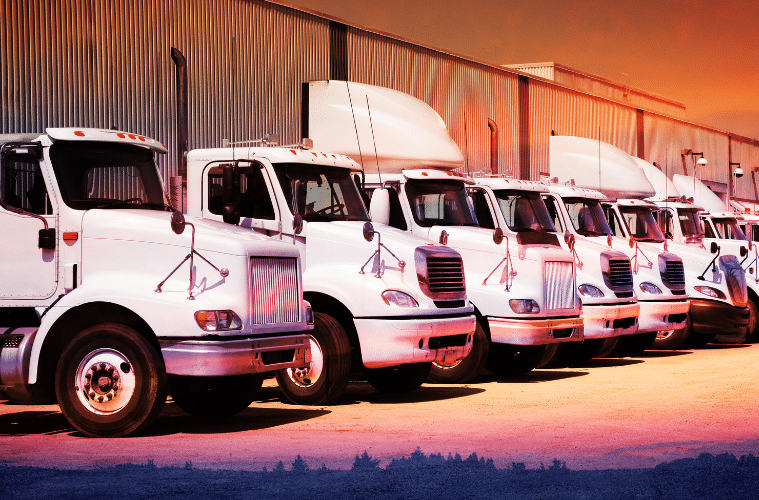May 16, 2024 8 min read

Guide to Fleet Safety: Ensuring Safe Operations Across Various Industries
Industry:
Solution:

For organizations that manage fleets, prioritizing safety is essential. It’s the cornerstone of operational success and plays an important role in protecting both employees and the public. Fleet safety crosses into many industries, incorporating a wide range of best practices, standards, and training programs designed to protect both physical assets and human lives and increase efficiency and prevent additional expenses.
Every year, motor vehicle accidents impose a significant financial burden on employers, totaling up to a staggering $60 billion. These costs encompass medical expenses, legal fees, property damage, and the productivity lost due to work interruptions and employee absences.
This blog explores the concept of fleet safety, highlights the industries that need to prioritize it, discusses the regulatory frameworks that oversee it, and examines how online training can be leveraged to bolster safety program initiatives.
What is Fleet Safety?
Fleet safety refers to the management practices, technologies, and policies designed to keep vehicles operating safely within a commercial fleet. This includes everything from routine maintenance checks, proper load securement, and entry-level driver training (ELDT) programs to the implementation of driver assistance technologies and adherence to safety regulations.
The goal of fleet safety programs is not only to protect the physical assets—the vehicles—but also to ensure the fleet driver safety, passengers, and the general public.
Preview our award-winning load securement safety case study course, designed to equip your fleet with the expertise needed to safely transport cargo, reducing the risk of accidents and ensuring compliance with industry regulations.
What Industries Should Prioritize Fleet Safety?
While almost every industry that operates vehicles could benefit from enhanced fleet safety protocols, certain sectors should place an even higher priority on these practices due to the inherent risks associated with their operations. Here are some key industries where fleet safety must be a top priority:
- Transportation: This sector forms the backbone of the global supply chain, involving extensive fleets of trucks, vans, and other vehicles that are essential for the delivery of goods. Due to the high mileage and long hours associated with these operations, emphasizing fleet safety is crucial to prevent accidents and ensure timely delivery of products.
- Public Transportation: Buses, trams, and subways are vital to urban infrastructure, transporting millions of passengers daily. The safety of these vehicles impacts not just those directly involved but also has a broader implication for public safety and urban mobility.
- Distribution Centers, Logistics, and Warehousing: This industry commonly operates fleets, especially if they are involved in the transportation of goods to and from the facility. These fleets typically consist of delivery trucks, vans, or even semi-trailers depending on the scale of operations and the nature of the goods being distributed. The fleets serve as a critical link in the supply chain, ensuring the movement of products from the warehouses to retail locations, other distribution centers, or directly to consumers.
- Utilities: Companies in the utilities industry often manage fleets that include specialized vehicles capable of off-road and challenging terrains. These vehicles are crucial for the maintenance of essential services like electricity, water, and gas. Safety protocols are necessary to protect the workers who operate these vehicles in potentially hazardous conditions.
- Construction: With a fleet that may include heavy machinery and construction vehicles, safety measures are vital to prevent on-site accidents. Given the varied environments and the heavy-duty nature of the equipment, construction vehicle safety is essential for protecting workers and ensuring project timelines are met without incident.
For each of these industries, prioritizing fleet safety not only helps in complying with regulatory requirements but also enhances operational efficiency, protects against liability, and most importantly, saves lives. Implementing safety protocols and continuous training ensures that fleet operations do not lead to preventable mishaps, fostering a safer working environment and a more responsible public presence.
Empower Your Fleet with Essential Safety Training – Learn How to Get Started
Ensure your drivers and team members are equipped with the knowledge and skills to navigate their work environment safely.
Get Started
OSHA’s Fleet Safety Program
The Occupational Safety and Health Administration (OSHA) does not provide a specific “fleet safety program,” but it sets forth guidelines and standards that significantly influence fleet safety regulations across various industries. These include general safety requirements related to vehicle operation, maintenance standards, and occupational health provisions that indirectly impact fleet safety.
For instance, OSHA’s guidelines on workplace safety and health standards compel employers to ensure that all vehicles are maintained in safe operating condition. Additionally, there are specific guidelines related to hazardous materials transportation, commercial driver’s license standards, and workplace noise standards, all of which affect fleet operations.

Fleet Standards to Follow
Beyond OSHA’s occupational standards, fleet operators often comply with additional regulations such as those from the Department of Transportation (DOT), the Federal Motor Carrier Safety Administration (FMCSA), and the National Highway Traffic Safety Administration (NHTSA).
These standards cover aspects such as adhering to DOT vehicle inspection regulations, driver rest periods (Hours of Service regulations), and vehicle safety standards (like brake and tire checks). Compliance with these regulations not only promotes fleet driver safety but also helps avoid significant legal and financial repercussions.
Ensuring Fleet Safety: Identifying Crucial Job Roles
Fleet safety isn’t just the responsibility of a single role within an organization; it requires a collective effort spanning several workforce positions:
- Fleet Managers: They are primarily responsible for the overall operation and management of the fleet, including adherence to safety programs.
- Safety Officers: Typically tasked with implementing and overseeing safety programs, conducting safety audits, and ensuring compliance with regulatory standards.
- Drivers: As the operators of fleet vehicles, drivers must be thoroughly trained on safe driving practices and the proper use of safety equipment.
- Fleet Maintenance Personnel: Ensuring that each vehicle is in top operational condition regardless of the season falls under their purview, directly impacting the safety of fleet operations.

Implementing Online Fleet Safety Training
With advancements in technology, online training has become an effective method to enhance focus on fleet safety. Here’s some tips on how organizations can implement a successful online training program:
- Job Role Specific Content: Utilize training modules that address the specific needs and risks associated with your industry’s fleet operations. Courses should include scenarios that cover real-world challenges, such as preventing collisions.
- Regular Updates: Fleet safety regulations and best practices evolve; hence, updating training content regularly is crucial to keep it relevant and compliant with the latest standards.
- Tracking and Reporting: Use an Learning Management System (LMS) to track progress and analyze the effectiveness of your training programs. This data can help refine training strategies and improve overall fleet safety outcomes.
- Competency Assessments: When implementing an online training program for fleet safety, it’s essential to begin by assessing fleet team member competencies, identifying areas for improvement, and tailoring the training content to address specific needs and skill gaps.
- Accessibility: Make training accessible on multiple devices, allowing employees to complete it at their convenience, which is particularly beneficial for fleets that operate across different time zones.
- Engagement and Interactivity: Incorporate interactive elements such as quizzes and knowledge checks to keep learners engaged and improve retention.
- Retention-focused: Prioritizing effective learning methodologies includes the incorporation of microlearning modules. These bite-sized lessons offer quick yet comprehensive insights into key fleet safety topics, allowing your team members to efficiently enhance their knowledge and skills even amidst busy schedules.
Creating Fleet Safety Programs with EHS Data Management
In addition to online training, implementing a comprehensive safety program involves robust Environmental, Health, and Safety (EHS) data management. Here are key elements to consider:
- Data Collection and Analysis: Utilize technology to collect and analyze EHS data related to fleet safety incidents, near misses, and compliance metrics. This data provides valuable insights into areas of improvement and helps in formulating targeted safety strategies.
- Risk Assessment and Mitigation: Conduct regular risk assessments to identify potential hazards and implement proactive measures to mitigate risks. This may include route planning, vehicle maintenance schedules, and fleet driver safety and behavior monitoring.
- Compliance Management: Stay abreast of regulatory requirements related to fleet safety and ensure compliance through regular audits and documentation. An integrated EHS management system can streamline compliance processes and reduce administrative burden.
- Continuous Improvement: Foster a culture of continuous improvement by encouraging feedback from fleet personnel and stakeholders. Regularly review safety performance metrics, recordkeeping processes, and adjust strategies as needed to enhance safety outcomes.
- Training Integration: Integrate EHS data management with online training programs to ensure alignment between safety initiatives and organizational goals. Use data insights to customize training content and address specific safety challenges faced by the fleet.
By combining online training with comprehensive EHS data management, organizations can create a holistic approach to fleet safety that enhances compliance, reduces risks, and fosters a culture of safety across the organization.
Explore the EHS Buyer's Guide
Dive deeper into the world of EHS data management with our comprehensive Buyer's Guide. Discover essential tools and technologies to streamline EHS data management, enhance compliance, and optimize safety outcomes for your fleet. Access the guide and revolutionize your approach to fleet safety today!
Download Guide
Safeguarding you Workforce Through Prioritized Fleet Safety
Fleet safety is a critical component that spans various industries and requires diligent attention to regulatory compliance, best practices, and effective training programs.
By prioritizing safety through structured programs and leveraging technology for training, organizations can significantly mitigate risks and enhance operational efficiency. Fleet safety not only protects a company’s assets but, more importantly, safeguards human lives.
Ready to get started with a comprehensive fleet safety program? Discover how our training and safety management solutions can elevate organizational focus on the safety and well-being of your fleet team members.








